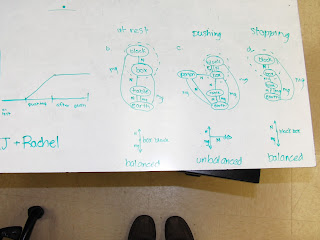We're wrapping up CAPM (constant acceleration motion) in honors physics, and one of the biggest ideas is determining the direction of an object's acceleration. It's very important once we start moving into force analysis, because it tells you about how the forces acting on an object are related, and sometimes tells you the direction of a force that you couldn't determine any other way (static friction, I'm looking at you!).
We took a second to stop and collect our list of ways to determine the acceleration of an object:
- From the x vs. t graph: is the slope increasing or decreasing? You have to be careful here to differentiate between getting steeper vs. flatter (which tells you about speed) and whether the value of the slope is increasing or decreasing (going from a zero slope to a negative slope is decreasing).
- From the v vs. t graph: is the slope positive or negative? There's your acceleration sign direction, too.
- From a diagram: is the object speeding up or slowing down, and what direction is it moving? The combination of the acceleration and velocity directions determines whether something's speeding up or slowing down, so you can work backwards to find the acceleration direction from the directions and relative sizes of the initial and final velocities. If you know that it's moving left and speeding up, you know that the acceleration's left as well. If it's moving left and slowing down, then the acceleration is in the direction opposite the velocity (so a is to the right, in this case).
- From the x vs t graph: is the graph concave up or down? That is, does it open upward or downward? Positive accelerations have concave up position graphs.
We applied this to an easy example using a ramp and a Pasco Visual Accelerometer. These are pretty neat little boxes that produce a green arrow or a red arrow to one side or the other, based one the direction in which it is accelerating. For some reason, kids will believe that little computer box with all of their hearts.
The second challenge was a little tougher: I roll a cart up the hill with the visual accelerometer on it, and let it go up to the top and then come back down. I asked the students to predict the direction (or directions) of the acceleration, and to defend their answers with at least two pieces of evidence (they have four possible lines of inquiry from our four methods above!).
This is one that always has the potential to stump my students. Detaching the directions of velocity and acceleration (indeed, differentiating that velocity and acceleration are actually two different things!) can be tough, as can detaching speed from velocity.
 |
| Which direction is it moving? You can't tell by this acceleration reading! |
They did very well with it, though, with most groups coming to the correct answer rather quickly and confidently. A big part of this seemed to be their use of these multiple lines of evidence to back up their decisions. Every approach that you take to a problem will give you an answer. Whether that answer's worth much? It's hard to say, if that's all you have to go off of. If you can attack the problem from multiple directions, then you can really have some confidence in it.
I definitely had groups draw iffy motion graphs during this. Most groups, however, as they used the diagrams and graphs to try to come to the same answer over and over again, noticed when one representation gave a different answer than the others, and were able to flip that velocity graph or look at the starting position more carefully.
This is what great problem-solvers do - they use multiple avenues to address a problem, letting the results of each one inform the others. It's not really a linear process, but an attack from multiple angles, until you break through, and then a mopping-up of all of those open threads, in order to make sure that everything line up as it should.
Once again, we see that:
Great problem solvers don't always get it right the first time - they just catch their own mistakes, so that the first answer that you see from them is right.
This idea about the non-linearity of problem solving doesn't just apply to problem-solving, though: the whole web of knowledge in your head really is a web. If you only connect each piece of knowledge to the next in a single chain or ladder, then it's difficult to tell when a thread breaks. After all, you'll always get an answer.
If, however, each piece is connected to many others, then one strand breaking isn't an issue, because you have several other ways to make that connection. This is really the secret of complex problem-solving, and pretty much the definition of knowing something cold (unconscious competence!).
Here's a web that I threw together for my knowledge connecting the kinematic quantities:
The most fundamental thing that makes my understanding deeper than the honors students' understanding at the moment is that I just know some more connections than they do (so far). Making this web as rich as possible is really your job as a learner. When teachers bemoan "surface understanding," cramming, and answer-hunting, it boils down to a difference in the process for a student - that student's goal directly impacts the level of understanding that he/she'll get out of the course.
So, how about it? Are you trying to get someone to tell you "the path to the answer," or are you building your own sprawling web of highways?













